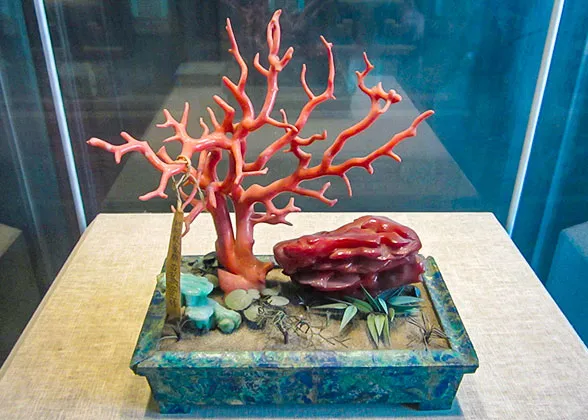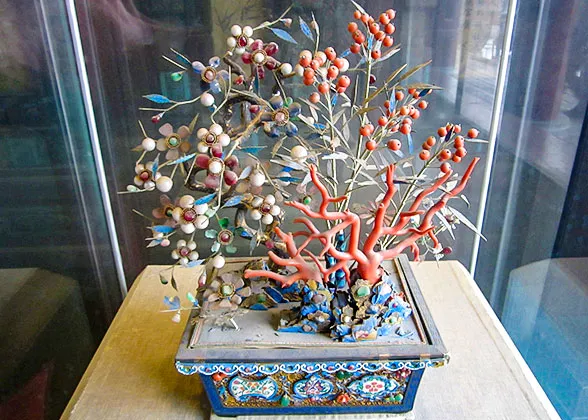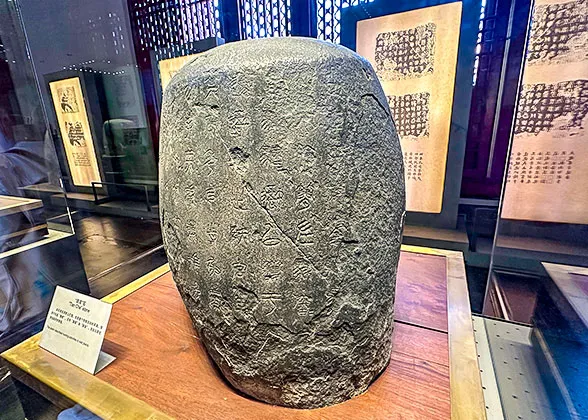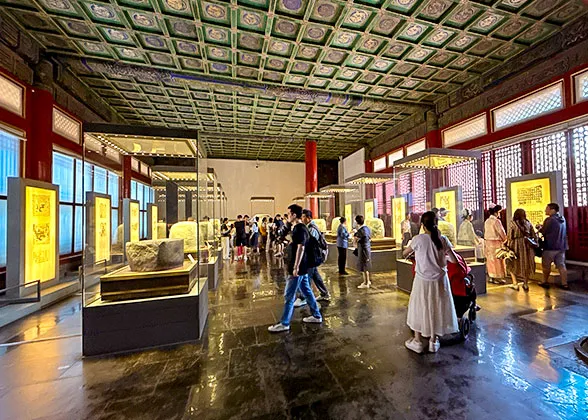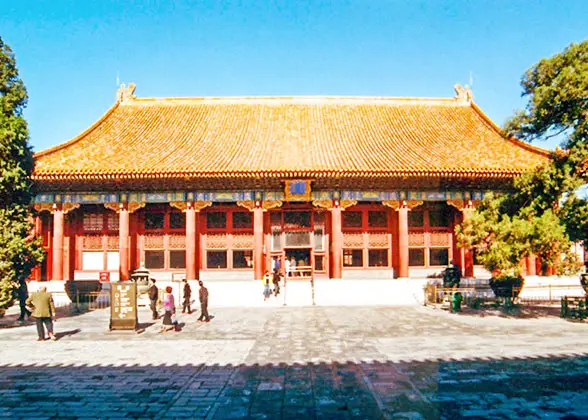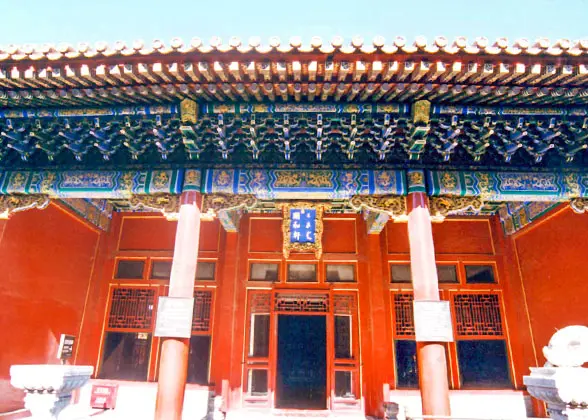Treasure Gallery (Zhenbaoguan)
The Treasure Gallery (Zhenbaoguan), located in the Palace of Tranquil Longevity Area (Ningshougong) to the east of the Gallery of Timepieces in the Forbidden City, showcases over 400 royal treasures selected from over 1.8 million pieces in the Forbidden City's collection, including jewels, gold, silver, jade etc.
Upon passing through the Gates of Imperial Supremacy and Tranquil Longevity, visitors can begin their treasure-hunt by turning right into the eastern corridor for sparkling royal jewelries.
This area displays Ming and Qing dynasty (1368~1911) jewelry accessories and gem-inlaid artifacts, featuring colorful minerals like jadeite and lapis lazuli, diamonds, rubies, and sapphires influenced by Western aesthetics.
 Must-see Exhibit: Empress Xiaojing's Phoenix Crown, 1573~1620
Must-see Exhibit: Empress Xiaojing's Phoenix Crown, 1573~1620
This stunning crown, 35.5 cm (14 inches) tall and 20 cm (8 inches) wide, weighs 2.95 kg (6.5 pounds). Adorned with cloud-shaped plaques of kingfisher feathers, the crown features 18 gemstone-inlaid plum blossoms. A pair of flying phoenixes grace the front, while three golden dragons crown its top, with the two outer ones holding jeweled tassels. From the back, six flaps of pearl and gemstone fan out. In total, 95 rubies and sapphires and 3,426 pearls are set across the piece. Its dazzling brilliance perfectly embodies the empress's exalted status.
This exhibition area showcases gold and silver artifacts, including ceremonial and practical utensils, religious relics, and decorative items. Displayed on red-backed cabinets, the exhibits sparkle with royal dignity and extravagance.
 Must-see Exhibit: Everlasting Solidarity Gold Cup, 1736-1796
Must-see Exhibit: Everlasting Solidarity Gold Cup, 1736-1796
Crafted from pure gold, the cup stands 12.5 cm (5 inches) tall with an 8 cm (3.15 inches) diameter, featuring intricate floral patterns adorned with pearls and vibrant sapphires. Two dragons serve as handles, their heads adorned with shimmering pearls like dragon eyes. And its unique elephant-trunk-footed design makes it a one-of-a-kind emperor’s drinking cup from the Forbidden City.
Visitors in this area will be greeted by precious jade artifacts, sourcing from Hetian jade from Xinjiang, jadeite, agate, and crystal.
 Must-see Exhibit: Jade Mountain with Ladies in the Shade of Paulownia
Must-see Exhibit: Jade Mountain with Ladies in the Shade of Paulownia
Crafted from pristine white jade, the 25 cm (10 in) tall masterpiece shows a serene courtyard with banana plants, paulownia trees, and greenery. A lady stands at the gate, while another lady peers through the door gap holding a ruyi scepter, adding a touch of life interest.
Originally scraps for a jade bowl, craftsman Wu skillfully carved them into this piece, transforming cracks into the door gap, letting light pass through. It's a true waste-to-treasure masterpiece.
This area features lifelike gemstone bonsais crafted from gold, silver, jewels, jade, coral, and ivory, which were emblematic of Qing royals’ luxurious lifestyles.
 Must-see Exhibit: Ruby Plum Tree Bonsai, 1662~1795
Must-see Exhibit: Ruby Plum Tree Bonsai, 1662~1795
A dazzling gilded basin, intricately engraved with swastikas and the character for "longevity" (壽) holds this masterpiece. The plum blossoms, crafted from 284 rubies and emerald-green jade leaves.
The basin centers on a gold-plated copper plum tree trunk, adorned with jade leaves, ruby petals, sapphire hearts, and gold stamens. Below, lapis lazuli, white jade, jade-leaf and coral-bead plants, agate camellias, and grasses are meticulously arranged.
In Qing Dynasty, plum blossoms symbolized "perpetual youth and longevity". This bonsai, crafted for imperial birthdays, perfectly encapsulates this theme.
Emperor Qianlong intended the Palace of Tranquil Longevity’s main hall as his retirement home, but never lived there. Later, Empress Dowager Cixi resided here, and now the main hall houses the Stone Drum Gallery.
The Gallery preserves 10 drums discovered in 820, which have survived wars and migrations to reach the Forbidden City. These drums date back to the 2nd century BC, recording First Emperor of Qin (259~210 BC) hunting activities and possessing significant cultural value, despite wear and tear over time.
Constructed by Emperor Qianlong in 1778 for his mother, and later used as his retirement home, the Hall features luxurious interiors adorned with jade, enamel, and precious woods. Today, it retains its original state from Empress Dowager Cixi's time, while other rooms display huge jade carvings.
 Highlight: Jade Mountain Sculpture Depicting Yu the Great's Flood Control Efforts, 1736~1796
Highlight: Jade Mountain Sculpture Depicting Yu the Great's Flood Control Efforts, 1736~1796
This 24-cm (9.6-inch) tall, 96-cm (37.8-inch) wide jade carving, with a 60-cm (23.6-inch) base and weighing 5,000 kg (1,023 pounds), is China's largest ancient jade sculpture. It depicts mountains, waterfalls, trees, caves, and people fighting with floods on cliffs, narrating the story of Yu the Great, who spent 13 years controlling the floods in the Yellow River (China’s second major river) basin about 4,000 years ago.
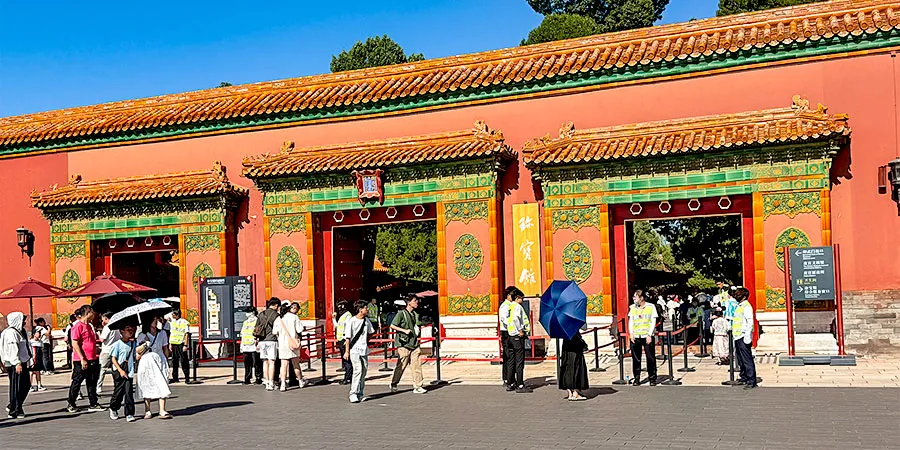 |
| Treasure Gallery, Forbidden City |
Hall of Imperial Supremacy (Huangjidian)
Upon passing through the Gates of Imperial Supremacy and Tranquil Longevity, visitors can begin their treasure-hunt by turning right into the eastern corridor for sparkling royal jewelries.
Jewelry Exhibition Area (Southeast)
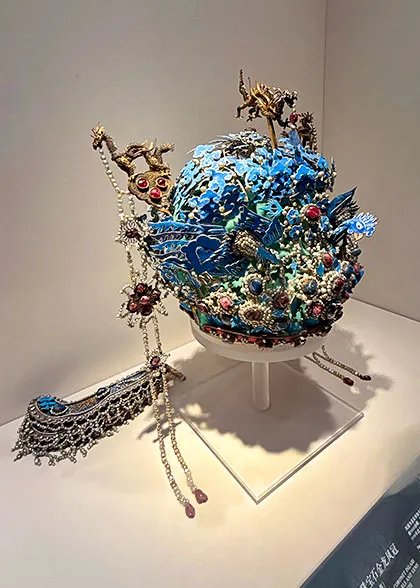 | 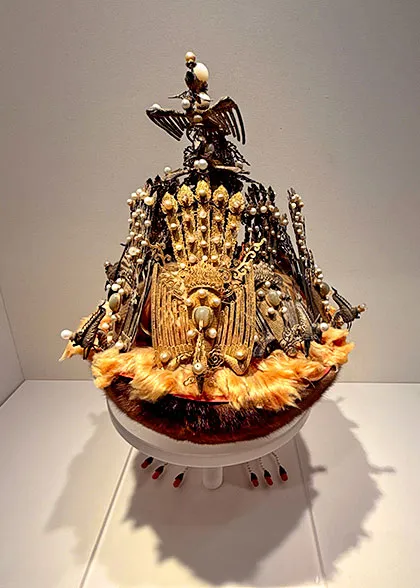 | 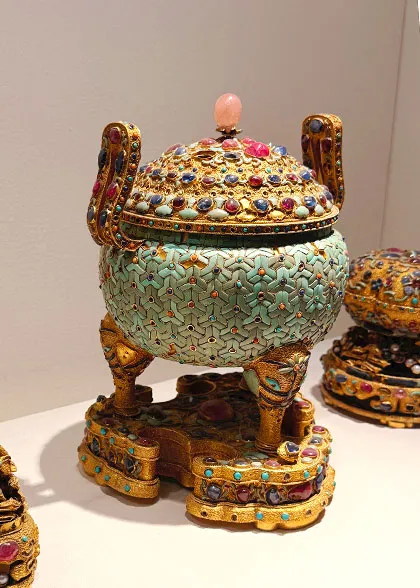 |
| Empress Xiaojing's Phoenix Crown | Empress Headgear | Gem-inlaid Enamel Bowl |
This area displays Ming and Qing dynasty (1368~1911) jewelry accessories and gem-inlaid artifacts, featuring colorful minerals like jadeite and lapis lazuli, diamonds, rubies, and sapphires influenced by Western aesthetics.
This stunning crown, 35.5 cm (14 inches) tall and 20 cm (8 inches) wide, weighs 2.95 kg (6.5 pounds). Adorned with cloud-shaped plaques of kingfisher feathers, the crown features 18 gemstone-inlaid plum blossoms. A pair of flying phoenixes grace the front, while three golden dragons crown its top, with the two outer ones holding jeweled tassels. From the back, six flaps of pearl and gemstone fan out. In total, 95 rubies and sapphires and 3,426 pearls are set across the piece. Its dazzling brilliance perfectly embodies the empress's exalted status.
Gold and Silver Exhibition Area (Northeast)
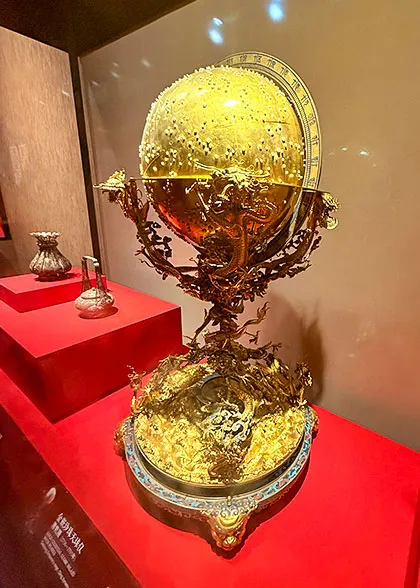 | 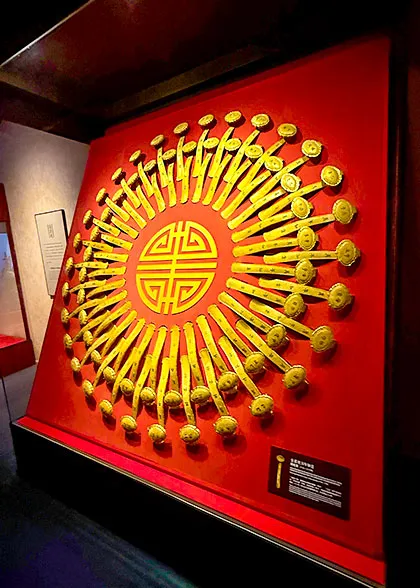 | 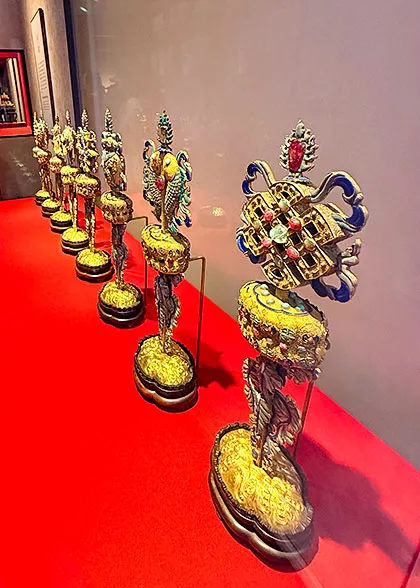 |
| Pearl-inlaid Gold Celestial Globe | 60 Gold S-shaped Scepters | Gold Exhibits |
This exhibition area showcases gold and silver artifacts, including ceremonial and practical utensils, religious relics, and decorative items. Displayed on red-backed cabinets, the exhibits sparkle with royal dignity and extravagance.
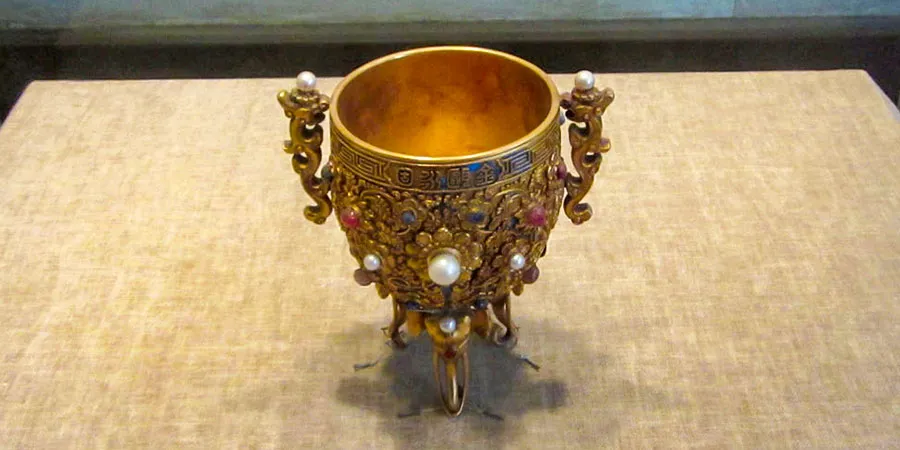 |
| Everlasting Solidarity Gold Cup |
Crafted from pure gold, the cup stands 12.5 cm (5 inches) tall with an 8 cm (3.15 inches) diameter, featuring intricate floral patterns adorned with pearls and vibrant sapphires. Two dragons serve as handles, their heads adorned with shimmering pearls like dragon eyes. And its unique elephant-trunk-footed design makes it a one-of-a-kind emperor’s drinking cup from the Forbidden City.
Jade Exhibition Area (Northwest)
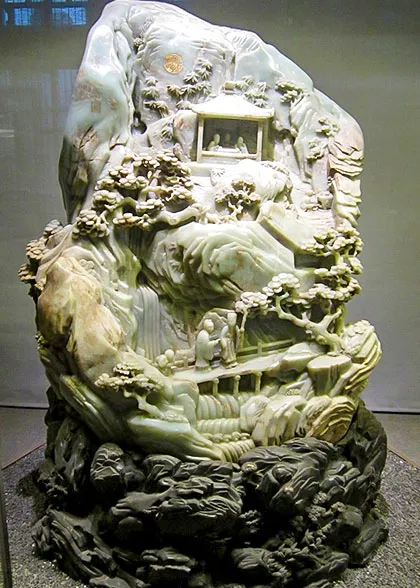 | 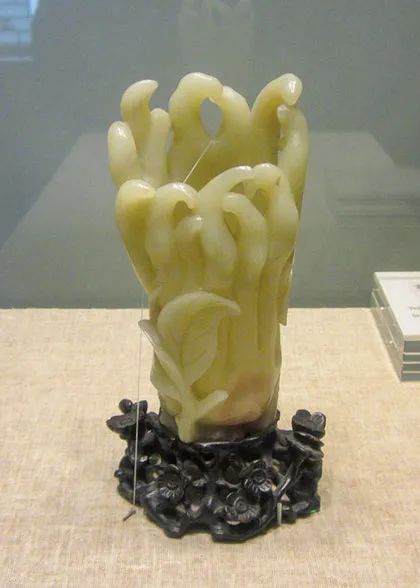 | 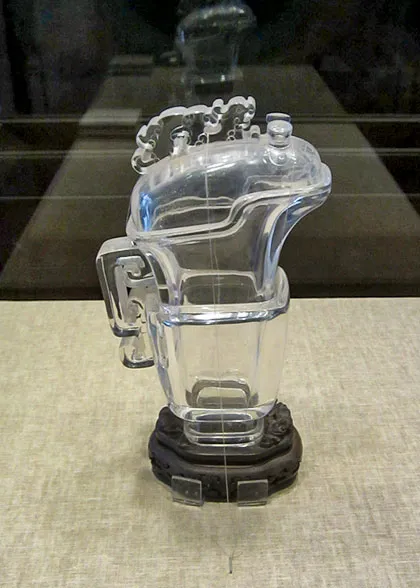 |
| Large Jade Carving | Jade Flower Holder | Crystal Cup |
Visitors in this area will be greeted by precious jade artifacts, sourcing from Hetian jade from Xinjiang, jadeite, agate, and crystal.
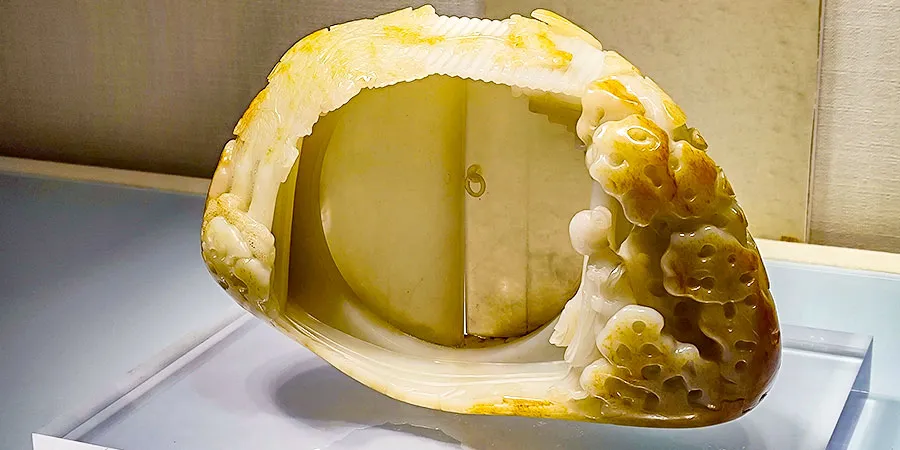 |
| Ladies in the Shade of Paulownia Jade Mountain |
Crafted from pristine white jade, the 25 cm (10 in) tall masterpiece shows a serene courtyard with banana plants, paulownia trees, and greenery. A lady stands at the gate, while another lady peers through the door gap holding a ruyi scepter, adding a touch of life interest.
Originally scraps for a jade bowl, craftsman Wu skillfully carved them into this piece, transforming cracks into the door gap, letting light pass through. It's a true waste-to-treasure masterpiece.
Bonsai Exhibition Area (Southwest)
|
|
This area features lifelike gemstone bonsais crafted from gold, silver, jewels, jade, coral, and ivory, which were emblematic of Qing royals’ luxurious lifestyles.
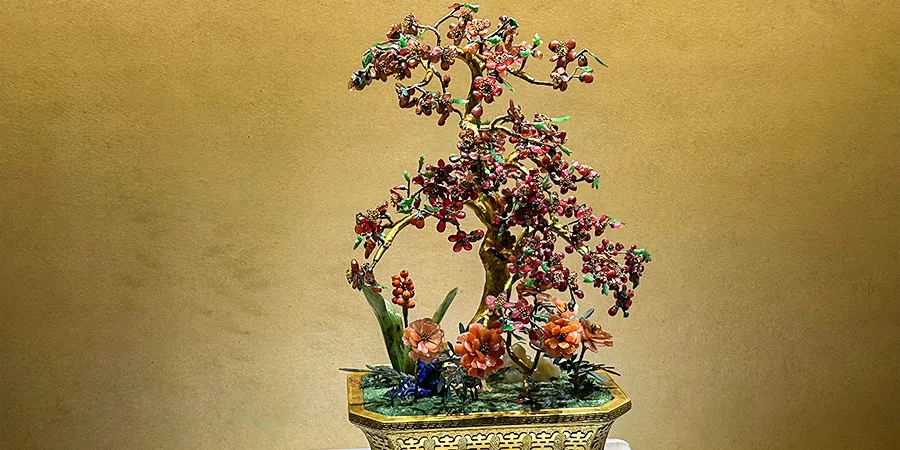 |
| Ruby Plum Tree Bonsai |
A dazzling gilded basin, intricately engraved with swastikas and the character for "longevity" (壽) holds this masterpiece. The plum blossoms, crafted from 284 rubies and emerald-green jade leaves.
The basin centers on a gold-plated copper plum tree trunk, adorned with jade leaves, ruby petals, sapphire hearts, and gold stamens. Below, lapis lazuli, white jade, jade-leaf and coral-bead plants, agate camellias, and grasses are meticulously arranged.
In Qing Dynasty, plum blossoms symbolized "perpetual youth and longevity". This bonsai, crafted for imperial birthdays, perfectly encapsulates this theme.
Palace of Tranquil Longevity (Main Hall)
Emperor Qianlong intended the Palace of Tranquil Longevity’s main hall as his retirement home, but never lived there. Later, Empress Dowager Cixi resided here, and now the main hall houses the Stone Drum Gallery.
Stone Drum Gallery (Shiguguan)
|
|
The Gallery preserves 10 drums discovered in 820, which have survived wars and migrations to reach the Forbidden City. These drums date back to the 2nd century BC, recording First Emperor of Qin (259~210 BC) hunting activities and possessing significant cultural value, despite wear and tear over time.
Hall of Joyful Longevity (Leshoutang)
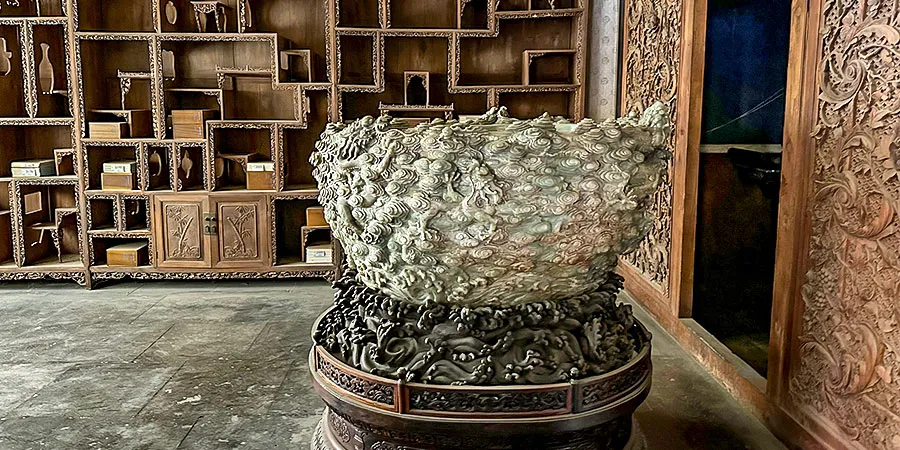 |
| Jade Mountain Sculpture, Hall of Joyful Longevity |
Constructed by Emperor Qianlong in 1778 for his mother, and later used as his retirement home, the Hall features luxurious interiors adorned with jade, enamel, and precious woods. Today, it retains its original state from Empress Dowager Cixi's time, while other rooms display huge jade carvings.
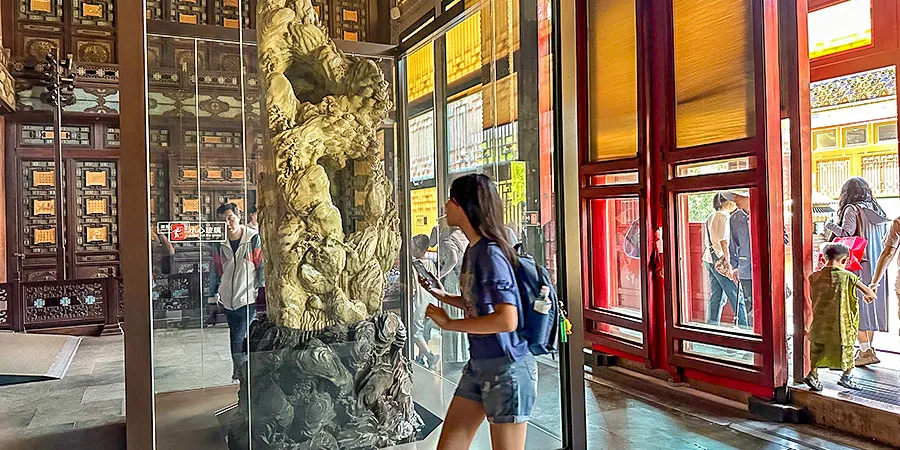 |
| Yu the Great's Flood Control Efforts Jade Sculpture |
This 24-cm (9.6-inch) tall, 96-cm (37.8-inch) wide jade carving, with a 60-cm (23.6-inch) base and weighing 5,000 kg (1,023 pounds), is China's largest ancient jade sculpture. It depicts mountains, waterfalls, trees, caves, and people fighting with floods on cliffs, narrating the story of Yu the Great, who spent 13 years controlling the floods in the Yellow River (China’s second major river) basin about 4,000 years ago.
Travel Tips
1. Opening Hours of the Treasure Gallery
| November 1 - March | 31 April 1 - October 31 | |
| Entry Begins | 8:30 | 8:30 |
| Ticket Check Ends | 15:30 | 16:00 |
| Last Entry | 15:40 | 16:10 |
| Closing Time | 16:30 | 17:00 |
2. Extra Ticket for the Treasure Gallery
To visit the Treasure Gallery, you need to purchase both the Forbidden City ticket (60 yuan) and the additional Treasure Gallery ticket (10 yuan).
3. Other Attractions within the Palace of Tranquility and Longevity Area
|
|
Except for the exhibits, of the Treasure Gallery, the Palace of Tranquility and Longevity Area welcomes visitors with open structures, like the Hall of Spiritual Cultivation (Yangxingdian), and the Belvedere of Well-Nourished Harmony (Yihexuan), displayed in their original state, along with other historical sites including the Qianlong Garden, the Pavilion of Pleasant Sounds and Hall for Viewing Opera. Also within this area lies the tragic Well of Consort Pearl (Zhenfeijing).
Go further west back to the central axis, visit the Imperial Garden (Yuhuayuan), or exit the Forbidden City through the Gate of Divine Prowess (Shenwumen).
How to visit the Forbidden City
Hindustan Jade Bowl in Treasure Gallery of Forbidden City
- Last updated on Nov. 20, 2025 by Jally Zhang -
